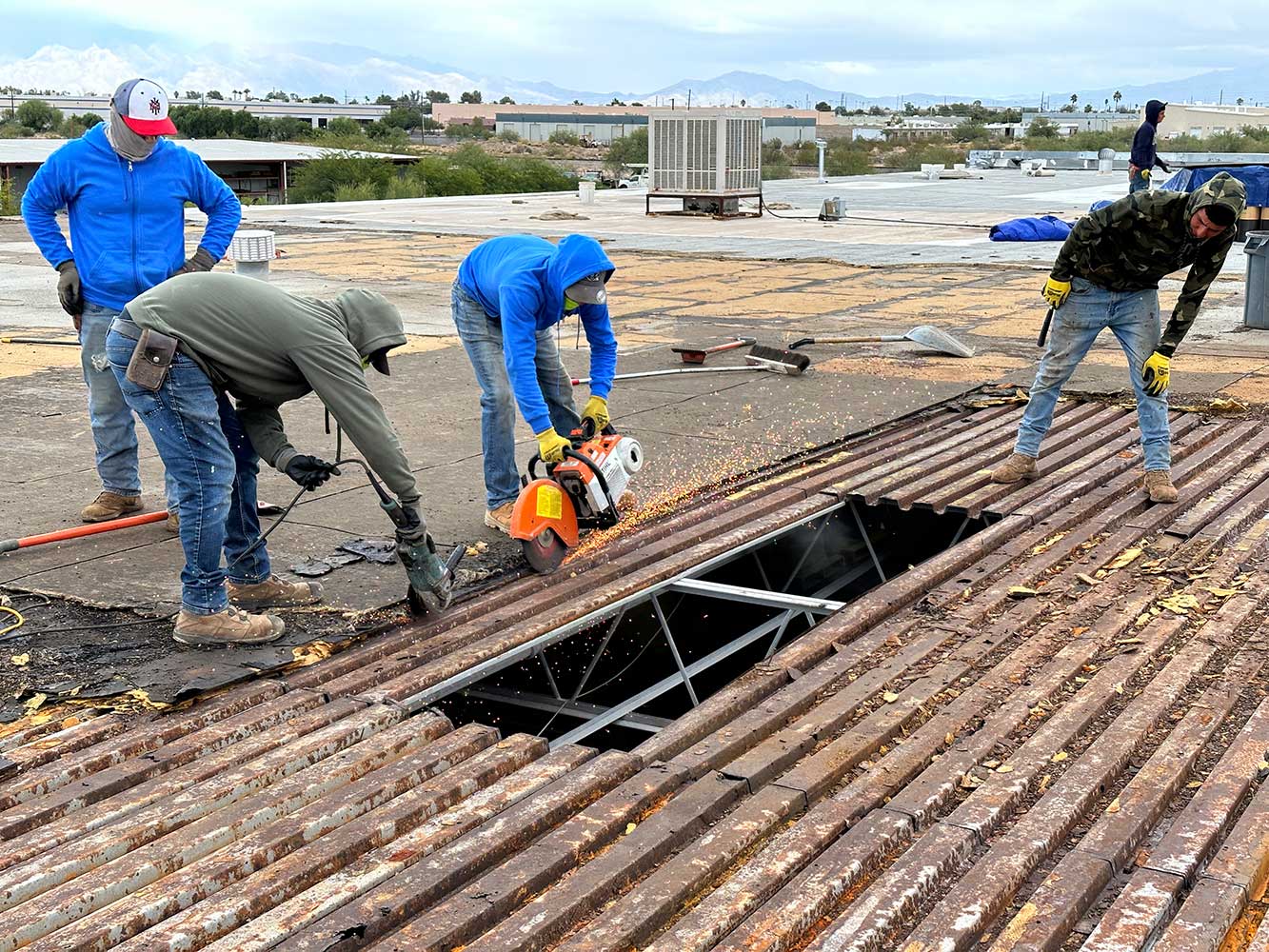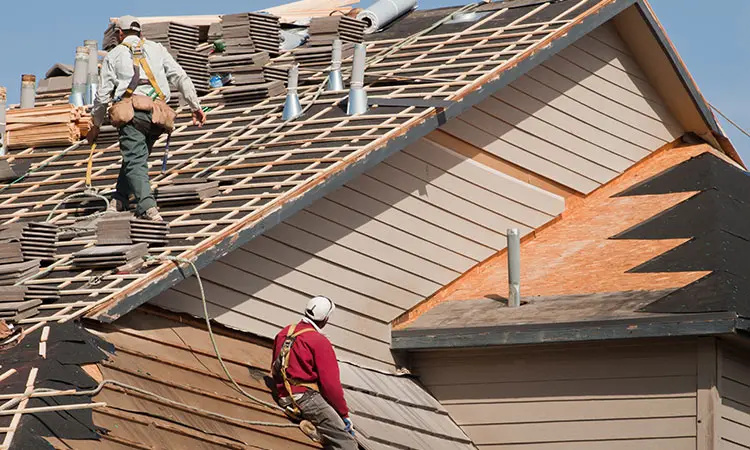Emergency Roofing System Fixing: What to Do When Disaster Strikes
When calamity strikes, examine your roofing system's damages thoroughly from a distance. Look for leaks, missing tiles, or sagging locations. Use roof tape or waterproof sealer to quickly secure little leakages, and utilize tarps for larger spaces. Document the damages with images for your insurance policy claim. If the damages is serious or persistent, contacting specialists is essential. To avoid future problems, routine inspections and upkeep are vital. There's even extra you can do to remain ready.
Evaluating the Situation: Security First
When you notice damage to your roof, evaluating the circumstance is vital for your security and the honesty of your home. If you see water discolorations on your ceiling, it's a clear sign that your roof's underperforming.
Next, think about the weather. If it's raining or gusty, wait till it's risk-free to examine additionally. Bear in mind, your safety and security comes initially. Call a professional contractor for a thorough evaluation if you think severe damage. Don't neglect any indications of prospective dangers; they could result in even more considerable problems down the line. Remain cautious, and take the needed safety measures to shield on your own and your home.
Temporary Solutions to Stop Additional Damages
When you spot a leak, act quick to seal it and avoid water damage. Utilizing tarpaulins can successfully cover at risk areas until a long-term solution is feasible. Plus, removing debris from your roof aids reduce the threat of more issues during tornados or hefty rain.
Seal Leaks Promptly
Recognize and seal leakages quickly to reduce damages during an emergency roof covering situation. Start by evaluating your roofing system for noticeable indicators of leaks, such as water stains or leaking. Maintain an eye on the weather condition and prioritize arranging a specialist repair as soon as possible to assure your roof is completely recovered and shielded.
Use Tarps Successfully
After securing any kind of noticeable leakages, using tarpaulins can give an effective short-term option to avoid more water damages. Secure it securely over the damaged section of your roofing system, making certain it expands at least a foot past the leak. Set up a specialist repair work as quickly as feasible to assure your roofing is fully recovered.
Remove Debris Quickly
To reduce water damage, without delay removing debris from your roofing system is important. If you observe any type of, thoroughly climb up and clear the roofing system.
If you can't reach the roof covering securely, think about employing an expert. Maintaining your roofing system clear not just shields your home but also provides you tranquility of mind throughout unforeseeable weather condition.
Identifying the Sort Of Roof Covering Damage
How can you tell if your roofing system has suffered damages? Start by inspecting your roof from the ground. Look for missing out on shingles, sagging locations, or any indicators of discoloration. If you can securely access your roof, check for splits, openings, or loosened products. Take note of flashing around chimneys and vents; harmed blinking can lead to leaks.
Look for water discolorations, mold and mildew, or damp insulation, which suggest possible roof leakages. After severe weather condition, take a moment to evaluate the circumstance.
If you identify any damages, it's vital to act promptly. Disregarding these indicators can lead to more substantial problems down the line. Bear in mind, security precedes; if you're uncertain about climbing up onto your roofing, take into consideration working with a specialist to analyze the damage for you.
Recording the Damages for Insurance Insurance Claims
When you've recognized roof covering damages, recording it for your insurance coverage claim comes to be crucial. Don't fail to remember to consist of wide shots of your whole roofing system for context.
Next, make a checklist of all visible damages, noting the specific areas and kinds of problems you discovered. If you can, write down the estimated size of the damages, as this details can sustain your claim.
Additionally, gather any kind of pertinent weather forecast or various other evidence that could support your insurance claim. Maintain receipts for short-lived repairs you make to reduce further damage if feasible. This documents will certainly not only help you throughout the insurance claims process however likewise assure you receive the settlement you are worthy of.
 roof repair
roof repairWhen to Employ Professional Aid
When your roof reveals signs of significant structural damages, it's time to contact the pros. Extreme climate condition can make DIY repair work high-risk, and relentless leaks or insect concerns frequently require experienced focus. Don't think twice to connect for help when you discover these caution indicators.
Significant Structural Damage
While you might feel tempted to take on roof repairs on your own, significant structural damages commonly requires expert knowledge. If you see drooping beam of lights, huge fractures, or extensive water damages, don't think twice to call in a roof professional.
Additionally, if your roofing has actually suffered damage from hefty impacts or dropped trees, it's important to have specialists evaluate the honesty of the structure. Remember, your safety and security is vital. Do not take unnecessary risks-- trust fund certified specialists to restore your roofing system and assure your home remains safe and safeguarded.
Severe Climate Condition
Severe weather can strike suddenly, and if you find yourself encountering high winds, heavy rainfall, or snow build-up, it's vital to assess your roofing system's problem rapidly. Seek any kind of noticeable damages, such as missing shingles or drooping areas. If you notice significant issues or if the tornado has created particles to accumulate, it's time to hire specialists. Don't risk climbing onto your roof in dangerous problems; leave it to the specialists who have the right tools and training. They can correctly examine the damages and suggest prompt repairs, ensuring your home keeps dry and risk-free. Keep in mind, acting quick can stop additional issues, so don't be reluctant to connect for aid when extreme climate hits.
Consistent Leakages or Parasites
If you've seen persistent leakages or indicators of insects in your home, it's essential to act quickly. These concerns can lead to extreme damage if left untreated. Overlooking these indicators can result in costly repair work down the line, so prioritize your home's safety and security.
Long-Term Repair Service Options to Consider
When you're prepared to relocate beyond emergency situation solutions, exploring long-lasting repair service alternatives can validate your roof stands strong versus future climate challenges. Begin by assessing the extent of damages; this will help you decide if restoring is sufficient or if a complete replacement is essential. If you're dealing with persistent leaks or structural concerns, take into consideration spending in high-quality materials, like steel or building roof shingles, which can supply enhanced sturdiness.
You might additionally wish to strengthen your roof's underlayment to enhance water resistance. Furthermore, consider mounting ventilation systems to prevent wetness buildup, which can bring about mold and rot. Employing a professional for an extensive examination can disclose covert problems and validate all fixings meet local codes. Remember, purchasing these long-lasting options now can conserve you from more considerable headaches-- and expenses-- down the line.
Tips for Future Roof Covering Maintenance and Readiness
To ensure your roof remains in fantastic shape, routine maintenance is crucial. Start by checking your roofing system at the very least two times a year. Seek missing shingles, cracks, or signs of wear. Do not fail to remember to check your seamless gutters, as well; blocked rain gutters can create considerable damages.
Trim looming branches to stop them from scratching your roof or dropping during storms. Consider using a protective sealant to expand your roof covering's life expectancy.
Keep an eye on your attic room for leakages and moisture, as this can suggest roof issues. Don't wait to address them-- very early treatment can save you cash and problem later. if you detect issues.
Last but not least, develop an emergency strategy. Know that to ask for fixings and have a budget plan collection aside for unanticipated problems. By remaining positive, you'll guarantee your roof stays safe and solid, prepared to hold up against whatever nature throws its way.
Regularly Asked Concerns
 roof repair
roof repairJust How Can I Inform if My Roofing Is Safe to Stroll On?
To figure out if your roofing's safe to walk on, look for noticeable damages, sagging areas, or loosened shingles. If you're not sure, it's ideal to seek advice from an expert before tipping onto the roofing. Safety first!
What Are Usual Indications of Roof Covering Damages to Seek?
You ought to look for fractured or missing shingles, water discolorations on ceilings, sagging locations, and granules in gutters. Noticing these indications early can assist you attend to potential issues prior to they come to be severe problems.
Can I Fix My Roofing Myself, or Should I Hire a Pro?
If you're comfy with heights and have the right devices,You can take on minor roofing repairs yourself. However, for substantial damage or facility concerns, employing an expert warranties safety and security and proper resolution.
What Devices Do I Required for Emergency Roof Covering Repair Works?
For emergency roofing fixings, you'll require a durable ladder, safety harness, roof cement, a caulking weapon, an energy blade, and tarps. Having these tools all set can help you address issues promptly and safely.
How Do Weather Condition Conditions Influence Emergency Roof Repairs?
Climate condition can significantly affect link to page your emergency situation roof covering repair services. If it's snowing or raining, functioning ends up being hazardous, and products may not adhere properly. Extreme temperature levels can likewise impact the treating and securing process, delaying repair work.
Identify and secure leakages rapidly to reduce damage during an emergency situation roof scenario. Secure it securely over the damaged area of your roof, making certain it expands at the very least a foot past the leak. Keep in mind, safety comes initially; if you're uncertain concerning climbing up onto your roofing system, take into consideration working with a specialist to assess the damage for you.
While you might really feel lured to tackle roofing system repair work on your own, significant architectural damage frequently requires specialist knowledge.In addition, if your roof covering has suffered damage from heavy influences or dropped trees, it's important to have experts examine the integrity of the structure.